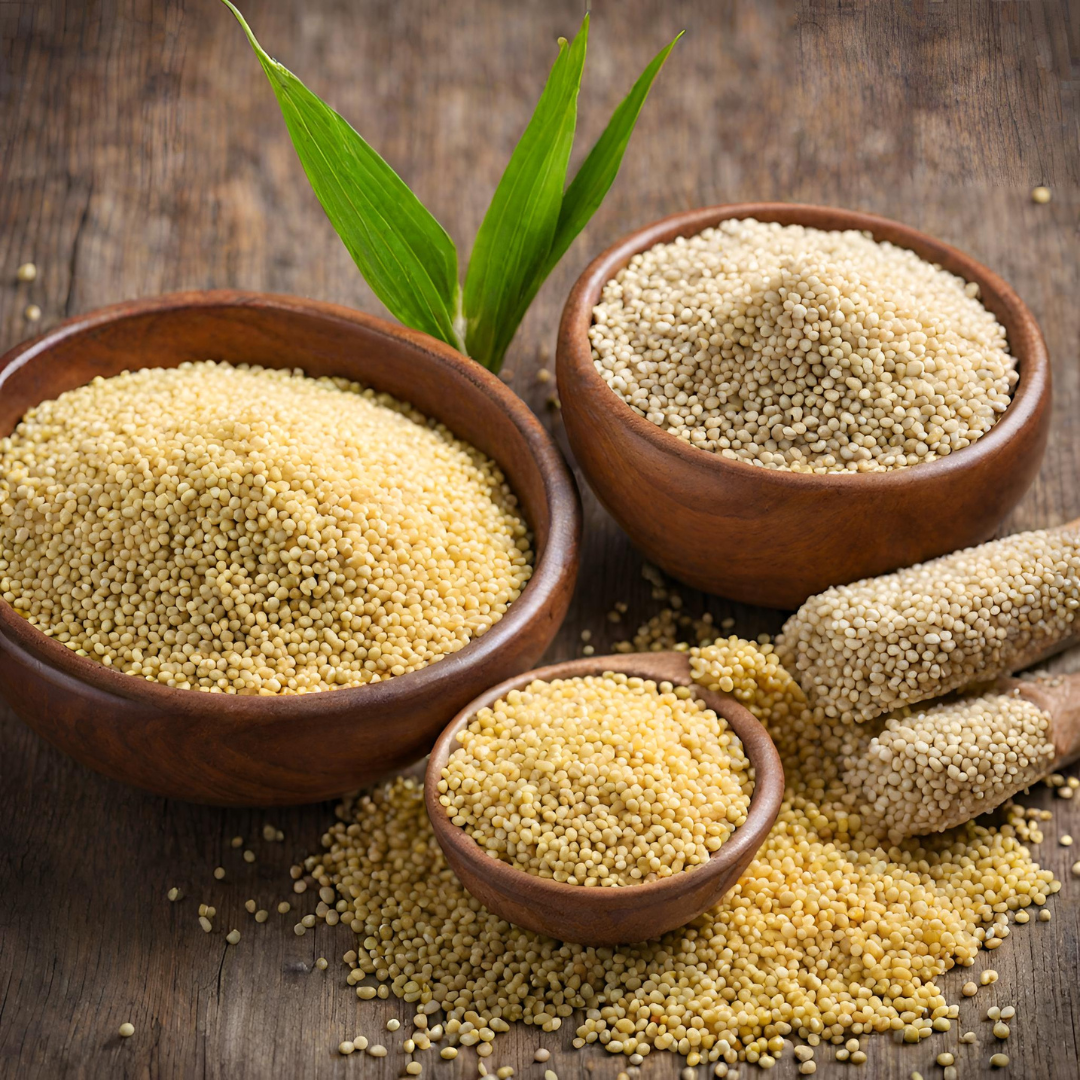

The Ultimate Guide to Millets for Weight Loss: Benefits, Types & Recipes
In recent years, millets have gained popularity as a nutritious and weight-loss-friendly grain. These small seed grasses, grown in semi-dry areas of Asia and Africa, have become a staple in many Indian households due to their numerous health benefits. With their high fiber content and complex carbohydrates, millets offer a satisfying and nourishing alternative to rice and wheat. In this comprehensive guide, we will explore the best millets for weight loss and how to incorporate them into your diet.
What are Millets?
Millets are a group of whole grains belonging to the Poaceae family. They are widely cultivated as cereal crops or fodder for animals. Millets are gluten-free and rich in protein, fiber, minerals, and antioxidants. In India, millets have been a part of traditional diets for centuries and are now gaining global recognition for their nutritional value.
The Nutritional Benefits of Millets
Millets are packed with essential nutrients that contribute to overall health and well-being. They are a rich source of dietary fiber, which aids in digestion, prevents constipation, and promotes a healthy gut. Millets also contain important minerals like iron, calcium, magnesium, and phosphorus, which are vital for various bodily functions. Additionally, millets are gluten-free, making them suitable for individuals with gluten intolerance or celiac disease.
Millets and Weight Loss
When it comes to weight loss, millets can be a valuable addition to your diet. Here are some reasons why millets are beneficial for weight management.
Fibre Content and Satiety
One of the key factors that contribute to weight loss is feeling satisfied and full after a meal. Millets are high in dietary fiber, which adds bulk to your diet and promotes a feeling of satiety. The fiber content in millets helps regulate blood sugar levels, prevents sudden spikes in insulin, and reduces cravings for unhealthy snacks between meals.
Complex Carbohydrates for Sustained Energy
Unlike refined grains, which are stripped of their fiber and nutrients, millets are complex carbohydrates that provide sustained energy throughout the day. This sustained release of energy helps prevent energy crashes and keeps you feeling full and satisfied for longer periods, reducing the urge to overeat.
Gluten-Free and Low Glycemic Index
For individuals with gluten intolerance or those following a gluten-free diet, millets offer a great alternative to wheat and barley. Millets have a low glycemic index, which means they have a minimal impact on blood sugar levels. This makes them a suitable choice for individuals with diabetes or those looking to manage their weight.
Types of Millets for Weight Loss
There are several types of millets available, each with its unique nutritional profile and health benefits. Let's explore some of the best millets for weight loss.
Sorghum (Jowar)
Sorghum, also known as Jowar, is a widely consumed millet in India. It is rich in dietary fiber, protein, and antioxidants. Sorghum is known to aid in digestion, promote heart health, and boost the immune system. It can be used to make rotis, porridge, and even popped as a healthy snack.
Pearl Millet (Bajra)
Pearl millet, commonly known as Bajra, is a nutrient-dense millet that is a good source of protein, fiber, and iron. It is known for its cooling properties and is often consumed during the summer months. Pearl millet can be used to make rotis, khichdi, porridge, and even desserts.
Finger Millet (Ragi/Nachni)
Finger millet, also known as Ragi or Nachni, is a powerhouse of nutrition. It is rich in calcium, iron, and essential amino acids. Ragi is known to control blood sugar levels, aid in weight loss, and improve bone health. It can be used to make rotis, dosas, porridge, and even cookies.
Little Millet (Vari)
Little millet, also known as Vari, is a small grain with big health benefits. It is rich in fiber, protein, and essential minerals. Little millet is known to improve digestion, regulate blood sugar levels, and promote weight loss. It can be used to make pulav, upma, and even desserts.
Kodo Millet (Kodra)
Kodo millet, also known as Kodra, is a nutritious grain that is rich in fiber, protein, and antioxidants. It is known to aid in digestion, regulate blood sugar levels, and promote weight loss. Kodo millet can be used to make pulav, upma, and even idlis.
Foxtail Millet (Rala)
Foxtail millet, also known as Rala, is a versatile grain that is rich in fiber, protein, and essential minerals. It is known to improve digestion, boost immunity, and aid in weight loss. Foxtail millet can be used to make pulav, upma, and even desserts.
Barnyard Millet (Jhangora)
Barnyard millet, also known as Jhangora, is a nutrient-dense grain that is rich in fiber, protein, and essential minerals. It is known to aid in weight loss, regulate blood sugar levels, and improve digestion. Barnyard millet can be used to make pulav, upma, and even porridge.
Proso Millet
Proso millet is a gluten-free grain that is rich in fiber, protein, and essential amino acids. It is known to aid in weight loss, improve digestion, and promote heart health. Proso millet can be used to make pulav, upma, and even dosas.
Browntop Millet
Browntop millet is a nutritious grain that is rich in fiber, protein, and antioxidants. It is known to aid in digestion, regulate blood sugar levels, and promote weight loss. Browntop millet can be used to make pulav, upma, and even khichdi.
Incorporating Millets into Your Weight Loss Diet
Now that we have explored the various types of millets for weight loss, let's look at some delicious and healthy ways to incorporate millets into your diet.
Millet Flour
Millet flour can be a great substitute for wheat or rice flour in various recipes. You can use Naario’s 9 in 1 flour mix (millet flour ) to make chapatis, pancakes, chilla, biscuits, bread, and even as a thickening agent or stabilizer for gravies and sauces.
Millet Semolina/Rawa Recipes
Millet semolina or rawa can be used as an alternative to regular semolina in dishes like upma, handwa, appam, dosas, idlis, and pongal. You can also find millet vermicelli to make delicious and healthy noodles.
Millet Rice/Pulav Recipes
Most whole millets can be cooked just like rice, making them an excellent substitute in pulav recipes. You can add colorful vegetables to make a nutritious and flavorful millet pulav.
Millet Khichdi and Pongal Recipes
Rice and dal make a classic combination in khichdi and pongal recipes. By replacing rice with millets like bajra, jowar, or foxtail millet, you can enjoy a tasty and nutritious meal without compromising on flavor.
Millet Salads and Porridge
You can use millets like barnyard millet, little millet, or foxtail millet to make a variety of nutritious salads. Just add an array of vegetables, a dash of lime, and you have a tasty and healthy treat. Millets can also be used to make porridge, such as ragi porridge or bajra kheer.
Comparing Millets with Other Grains for Weight Loss
While millets offer numerous health benefits, it's essential to compare them with other grains to understand their unique advantages.
Millets vs. Brown Rice
Brown rice is often considered a healthier alternative to white rice. However, millets offer several advantages over brown rice when it comes to weight loss. Millets have higher protein and fat content, along with a lower carbohydrate content compared to brown rice. Millets are also rich in fiber, which aids in digestion and keeps you feeling fuller for longer.
Millets vs. Quinoa
Quinoa has gained popularity as a super grain due to its nutritional profile. While quinoa is a complete protein, millets offer their unique benefits. Millets are gluten-free and have a lower glycemic index than quinoa. Additionally, millets are more affordable and easily accessible compared to quinoa.
The Safety of Consuming Millets Daily
Millets are generally safe to consume daily; however, it's essential to practice moderation and balance in your diet. Some researchers suggest limiting millet consumption to three or four times a week to avoid potential thyroid issues. It is also essential to include a variety of grains in your diet to ensure a well-rounded nutritional intake.
Conclusion: Making Millets a Part of Your Weight Loss Journey
Incorporating millets into your weight loss diet can be a game-changer. With their high fiber content, complex carbohydrates, and numerous health benefits, millets offer a satisfying and nourishing alternative to rice and wheat. Whether you choose ragi millets, foxtail millets, or any other variety, adding these nutrient-packed grains to your meals can support your weight loss goals while providing essential nutrients for overall well-being.
You can also kickstart your Millet Journey with Naario’s preservatives-free millet products such as Millet Muesli, 9 in 1 flour mix, and Ragi Bhakhri Snack. So, start exploring the best millets for weight loss and embark on a healthy and nutritious journey today.
Disclaimer: This article is for informational purposes only and should not be considered as medical advice. Please consult with a healthcare professional or registered dietitian before making any significant changes to your diet.
